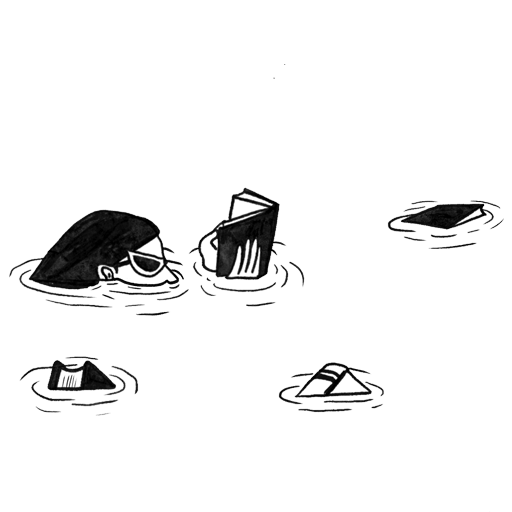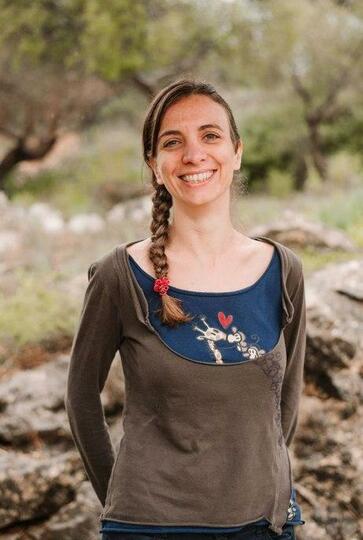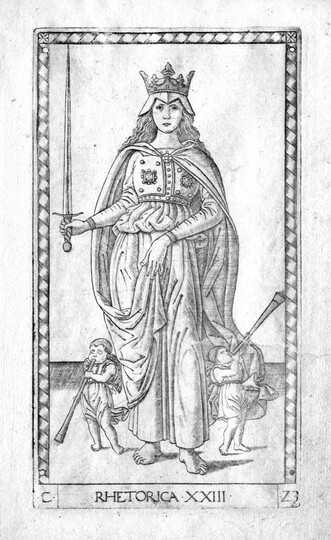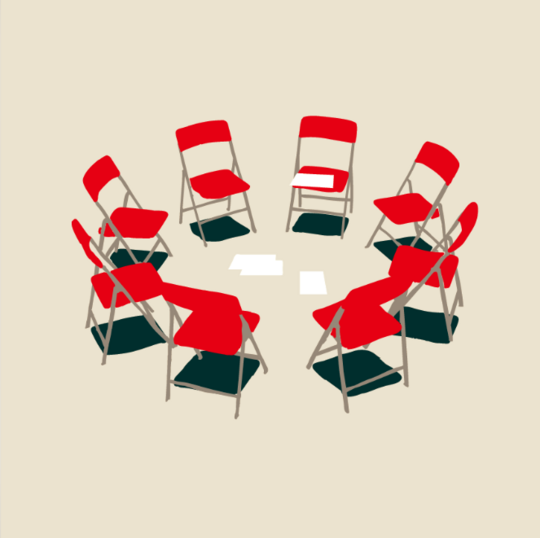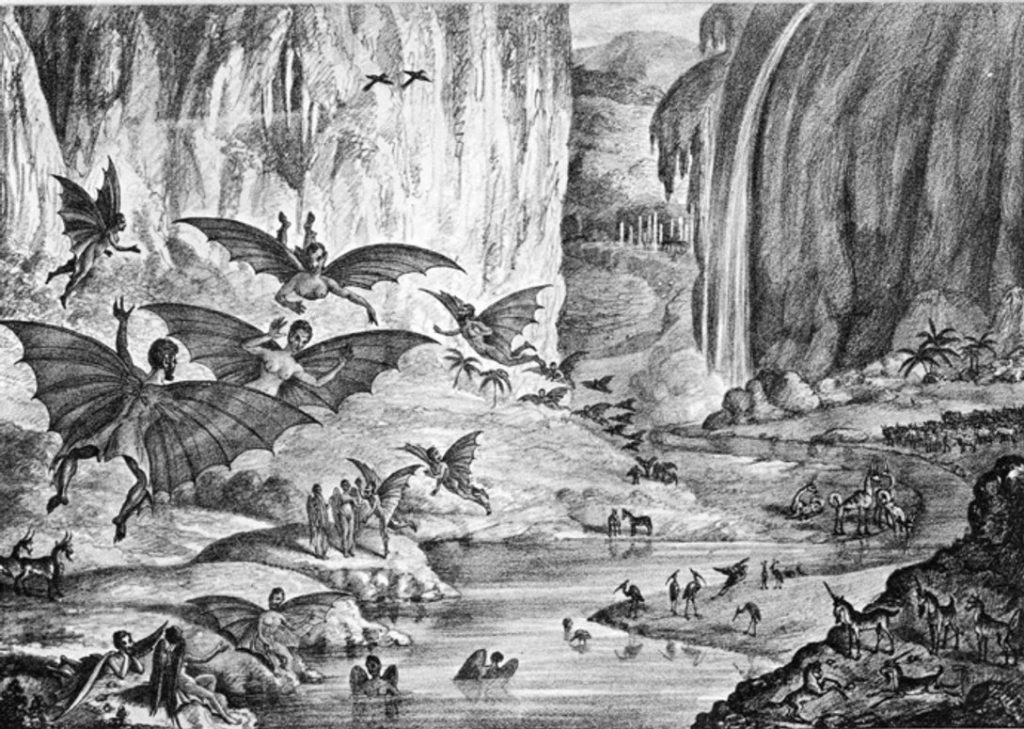
Did you know that in the mid-19th century, thanks to the great scientific advances made by the astronomer Sir John Herschel, the vespertilio homo –a short-haired, shiny creature with wings composed of a thin, hairless membrane– was discovered on the Moon?
The news, credited to the Edinburgh Journal of Science, went viral in 1835 when it was published in The Sun newspaper. The scoop generated a huge popular stir, boosted the newspaper’s sales and profits, and became the first fake news in contemporary history, named the Great Moon Hoax.
How could the people of that time have swallowed such a hoax?
“Apart from the technological innovation brought about by trains, steamships, fast presses, voicing children and low prices, there was one more factor that contributed to the spread of the 1835 hoax: the credulity of the masses in the new media.”
Recently, the Moon has been the protagonist of another hoax when a video of a giant moon at the North Pole went viral. Although the video was created and shared on the TikTok account of a digital creation artist, some accounts have shared it as if it were a real phenomenon and the lie has shocked social networks.
Different hoaxes, same Moon; different media, same credulity, what can we learn from historical hoaxes to combat disinformation?
In this article, we look back to understand how the production, distribution and consumption of hoaxes has evolved. The past is an excellent source of learning if we know how to read it correctly and, therefore, we want to include librarians as guarantees — yesterday, today and always — of access to quality information. Likewise, we also focus on young people and teachers, protagonists in the process of building an active citizenship with critical capacity.
Why do we think this question is relevant?
Disinformation is not a new phenomenon and History is full of falsehoods: some have changed the course of events, others have generated succulent profits for a few, others have reinforced prejudices and generated collective moods, and many have provoked violence.
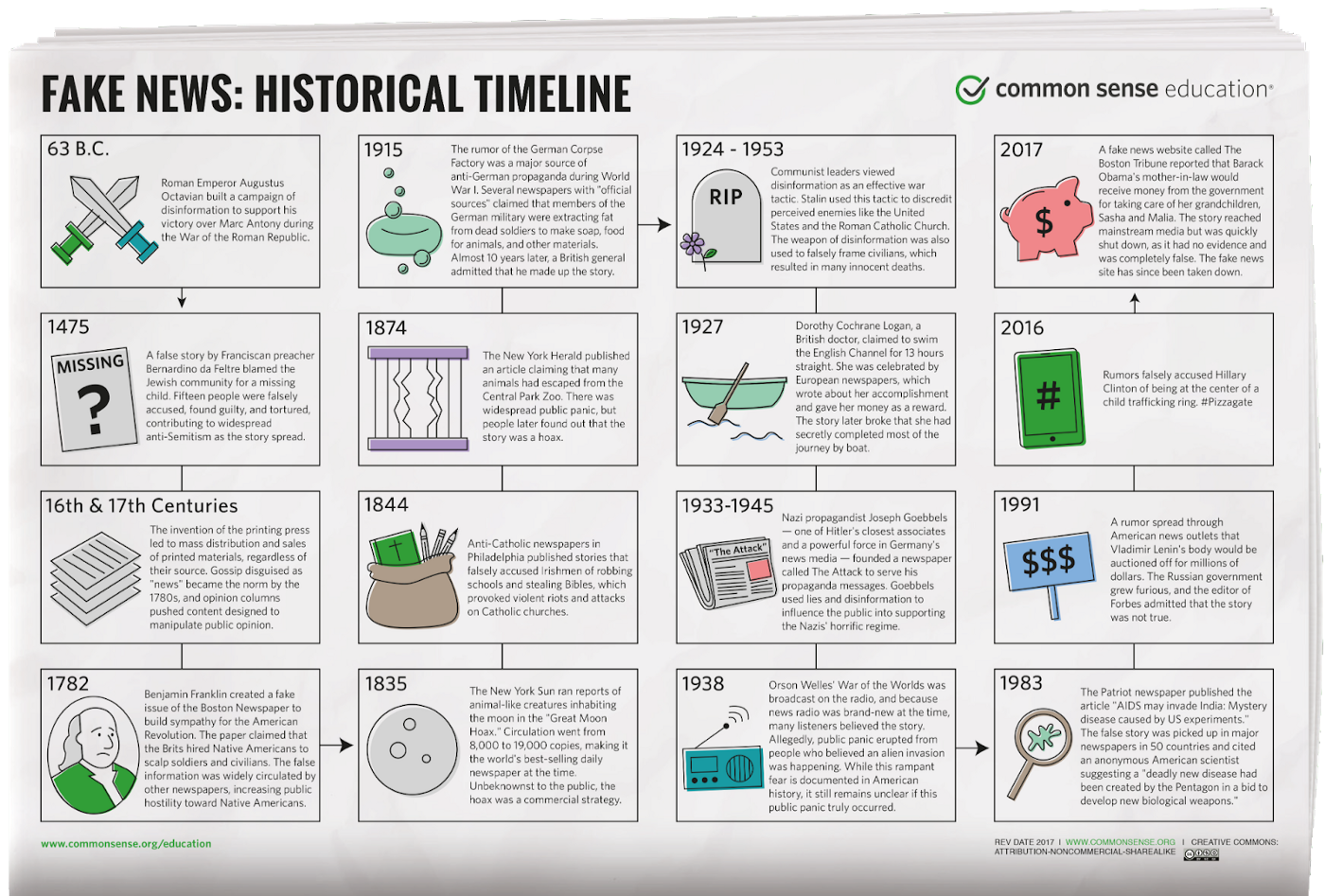
Chronology of some historical fake news.
The history of disinformation alerts us to the damage that this phenomenon can cause in multiple social dimensions, from the political system and international relations to migration or climate policies, among many others. Recently, we have seen its impact in the health field with the appearance of Covid-19, to the point that the WHO had to warn of an infodemic or overabundance of information superimposed on the pandemic.
As the Reuters Institute Digital News Report 2020 points out, disinformation is a concern in countries where the use of social networks is high and traditional institutions are weak. In this sense, an own study has analysed the context of disinformation in the Spanish State and the situation it reveals is worrying for several reasons, to highlight:
- The lack of credibility of citizens in public institutions and the media,
- The increase in the number of people who get information through social networks, and the increase of disinformation on these platforms,
- The porosity of citizens facing disinformation, exacerbated by the high (and traditional) political polarisation.
In this context, fighting disinformation is urgent and essential. To this end, we propose to review the past and, from the distance, learn from historical hoaxes to avoid being fooled again.
State of the art
The power to (dis)inform
Since the invention of the printing press, newspaper, radio and television publishers have monopolized the power to inform. Under their mandate, or editorial line, it was decided what was newsworthy and what was necessary to highlight, who was given a voice and who was kept on the sidelines. Consequently, they have also been responsible for the dissemination of historical hoaxes, from the vespertilio homo to the Zinoviev letter, among many others.
In today’s cyber society, the phenomenon of disinformation has become globalized. Nowadays, those who create and spread hoaxes can be both people with certain ideological interests and people with computer skills looking to make some money. In addition, the new digital framework has led to a large increase in the number of senders, incorporating new actors into the information distribution cycle who can disseminate unverified content.
If, in 1835, someone doubted the existence of the vespertilio homo “only” had to wait a few months for the arrival of the Edinburgh Journal of Science to verify the information, or to discover that the newspaper had ceased printing in 1833. If, in 2021, someone doubts the authenticity of the video of a giant moon, they only have to surf the internet for a few minutes or hours to verify the information.
Just as the phenomenon of disinformation has globalized, so has information. Nowadays, we are facing a paradigm shift in which people are no longer passive consumers of (dis)information, but opt for an active role in the cycle of production, distribution and consumption of information. The power to inform has been distributed.
Media for (dis)information
In late 1938, Orson Wells dramatized “The War of the Worlds” on his radio program. For the public’s entertainment, the production team (The Mercury Theatre) decided to adapt H. G. Wells’ novel to the radio medium and used a news-bulletin format to relate the alien invasion. Although warned of the fiction, many people believed the story and panicked, or so the myth goes.
This event, which was repeated years later at Radio Quito with a tragic ending, is known for showing the power of the media, either because of the panic caused by the fictitious newscast or because of the media’s magnification of what happened.
The credulity of the masses in the emerging media gives power to those who control such media. In this context, disinformation is a powerful tool for creating fictitious realities or exaggerating certain events that have an impact on the population and ultimately benefit the interests of those who control the media.
Unlike traditional media, the new media –in addition to having increased the number and diversity of senders– present some characteristics that favor a larger tendency to disinformation:
- Social networks collect and present a variety of news from all types of media, regardless of the quality or reliability of the original source.
- In both social networks and messaging applications, much news are received through friends, family or people we follow, a fact that causes a greater predisposition to believe the information received.
- In social networks, the popularity of content is counted through likes or number of views. The higher the count, the more likely people are to tune in to the story, although such popularity has (perhaps) been inflated by the use of online bots.
While hoaxes have exploited the characteristics of the new media, we also find proposals that take advantage of these characteristics to promote knowledge and information. On the one hand, fact-checking organizations have used social networks to fight online disinformation and encourage participation. On the other, Wikipedia has leveraged the redistribution of power to create an open, collaborative and distributed place of knowledge, with a strong reference base underpinning content, a system of historical traceability and open dialogue pages for controversial topics. In this model, information is no longer a single, unidirectional “truth” but a shared and distributed experience and knowledge.
Contents for disinformation
The purpose of disinformation is and has always been to deceive or manipulate the public to achieve certain self-interested objectives. Although we find hoaxes on various topics, the most abundant have traditionally been those related to politics, migration and science. However, hoaxes adapt to the events and trends of the moment, as we have seen in recent months with the coronavirus pandemic and the exponential growth of health-related hoaxes.
In the historical analysis of disinformation, it should be kept in mind that evidence can change over time, as knowledge evolves dynamically and in real time. A recent example can be found on the twitter of the World Health Organization (WHO), who at the end of March 2020 stated that Covid-19 was not airborne:
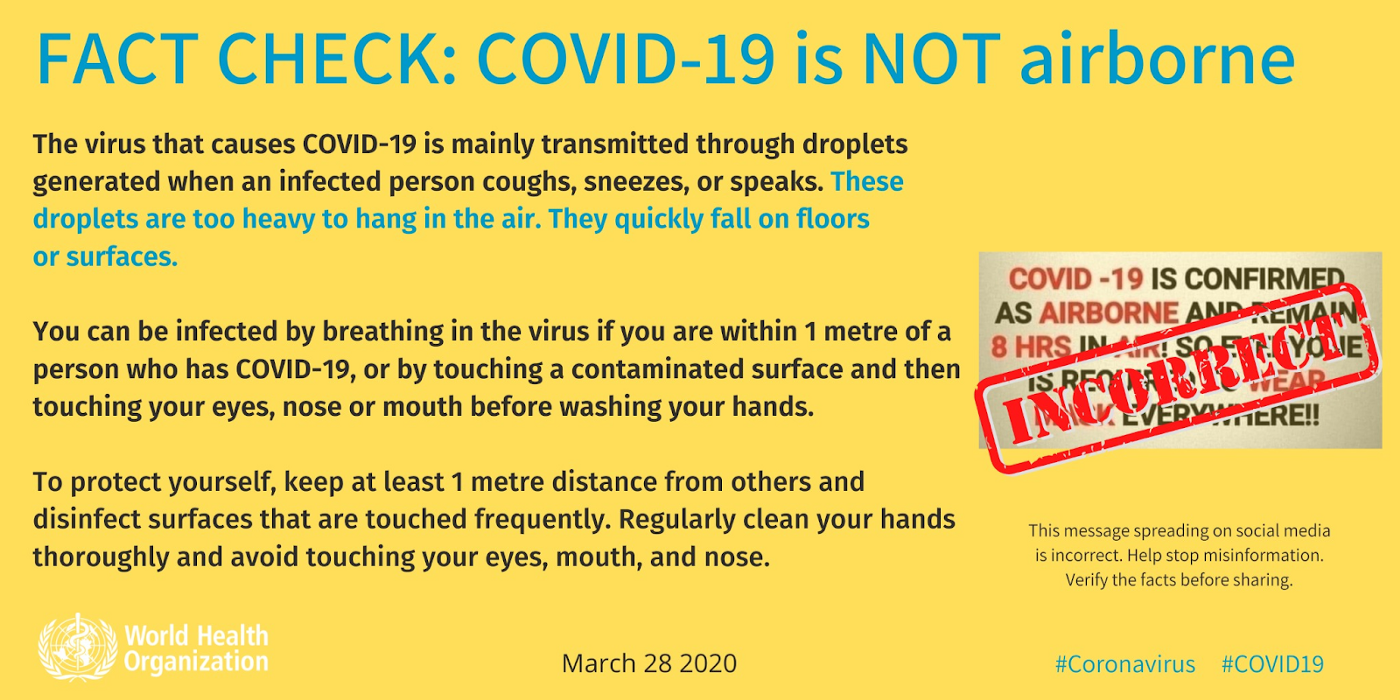
FACT CHECK: COVID-19 is NOT airborne.
Therefore, not all historical news that have turned out to be false have been made with the intention of disinformation. In these cases, both to avoid public confusion and to maintain the credibility of who issued the news, it is necessary to establish a historical traceability system that allows tracking of evidence and news. However, few platforms offer this feature. Again, we return to the Wikipedia model, which presents a historical traceability system that allows retracting and correcting truths that, over time, ceased to be so.
Despite the criticism and that Wikipedia is not a reliable source, recent events have shown how this platform has managed to keep disinformation at bay in times of pandemic and infodemic, proving to be a model to be considered with both in the promotion of knowledge and in the fight against disinformation.
Story of us
67% of the people surveyed for the Digital News Report Spain 2021 are concerned about disinformation, being Spain one of the countries analyzed by Reuters Institute where there is more social unease about this phenomenon. The report also reveals that there is more concern about disinformation circulating through social networks and instant messaging applications (50%) than the one disseminated through news channels (11%). However, six out of ten Internet users up to 45 years of age (61%) use social networks as a source of information.
The Study of the conditioning factors of disinformation carried out by the INECO research group highlights that more than half of the Spanish citizenship presents a relevant degree of vulnerability to disinformation, and points out that young people are the most vulnerable group.
On the other hand, the people interviewed in our baseline study agree that, although media literacy is not being worked on much, there is a great interest and educational demand for training on disinformation for both students and teachers. They also emphasize the need to provide young people with the skills to critically analyze information.
The story of now: how do we at Platoniq try to answer the question
In the face of misinformation, the experts insist on the need to disseminate manuals or codes of good practice and consider that citizen training, media and digital literacy, and the creation of critical awareness are the only ways to combat info-demia.
From Platoniq we fully agree on the need to teach literacy, create critical citizens and reinforce democratic values, with a special focus on young people who, besides being unprepared to deal with the flood of information that reaches them digitally, are the present and the future of society.
In this sense, we are involved in the SMILES European project in which we are committed to training teachers and librarians so that they can develop workshops against disinformation with high school students. We also want to work together with Wikipedia and Verificat to create community and value models of production and verification of information from a critical, shared and distributed perspective.
Call to action
- Do you want to reclaim the role of libraries as an umbrella against disinformation and a place for training critical users?
- Can you imagine creating an atmosphere similar to the one Orson Wells engineered to talk about disinformation with your students and empower their critical thinking?
- Want to show your teachers that Wikipedia is a reliable repository of information?
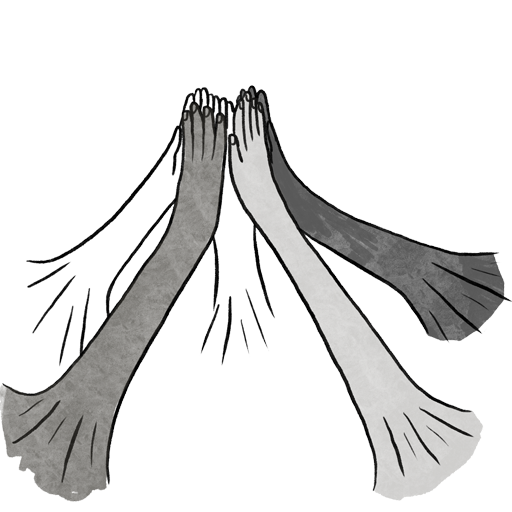
Resources and references
- Anducas-Armengou, Marta & Nadesan, Nadia. (2021). SMILES Baseline Study — Country Report. Fundación Platoniq. [https://smiles.platoniq.net/uploads/decidim/attachment/file/101/Baseline_study_-Country_report_Spain-ES.pdf](https://smiles.platoniq.net/uploads/decidim/attachment/file/101/Baseline_study-_Country_report_Spain-ES.pdf)
- Amoedo, Avelino; Kaufmann, Jürg; Moreno, Elsa; Negredo, Samuel & Vara-Miguel, Alfonso. (2021). DIGITALNEWSREPORT.ES 2021: Periodismo de calidad y cercanía para combatir la infodemia. Digital News Report. https://www.digitalnewsreport.es/
- DiResta, Renée. (2021, July 21). Institutional Authority Has Vanished. Wikipedia Points to the Answer. The Atlantic. https://www.theatlantic.com/ideas/archive/2021/07/cdc-should-be-more-like-wikipedia/619469/
- Gelado-Marcos, Roberto & Puebla-Martínez, Belén. (2019). Estudio de los factores condicionantes de la desinformación. Laboratorio de periodismo. https://laboratoriodeperiodismo.org/estudio-sobre-la-desinformacion/
- Ramon-Vegas, Xavier; Mauri-Ríos, Marcel; & Rodríguez-Martínez, Ruth. (2020). Redes sociales yplataformas de fact-checking contra la desinformación sobre la COVID-19.Hipertext.net, (21), 79-92. https://doi.org/10.31009/hipertext.net.2020.i21.07
- Salas Abad, Carlos. (2019). The first fake news of History. Historia y Comunicación Social, 24(2), 411-431. https://doi.org/10.5209/hics.66268
- Scolari A., Carlos. (2021). «La guerra de los mundos»: la invasión transmedia. CCCBLab. https://lab.cccb.org/es/la-guerra-de-los-mundos-la-invasion-transmedia/
- Soll, Jacob. (2016, December 19). The long and brutal history of fake news. Politico. https://www.politico.eu/article/fake-news-elections-trump-media/
- Starmans, Barbara. 10 Examples of Fake News from History. The social historian. https://www.thesocialhistorian.com/fake-news/
- Timsit, Annabelle. (2019, February 12). In the age of fake news, here’s how schools are teaching kids to think like fact-checkers. Quartz. https://qz.com/1533747/in-the-age-of-fake-news-heres-how-schools-are-teaching-kids-to-think-like-fact-checkers/
- A Brief History of Fake News. CITS. https://www.cits.ucsb.edu/fake-news/brief-history
